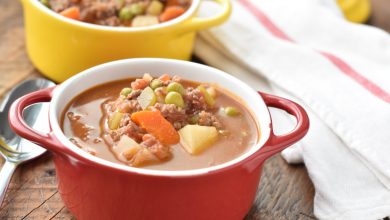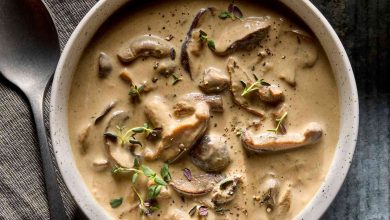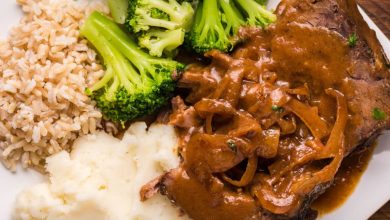Authentic German White Loaf Bread Recipe
German Kastenweißbrot (Classic German White Loaf Bread) 🥖
If you’ve ever found yourself reminiscing about the hearty, crusty loaves of white bread from a quaint German bakery, this German Kastenweißbrot recipe will transport you straight back to those cherished moments. This recipe, lovingly translated from the “Brot Backen” cookbook, captures the essence of traditional German bread baking. Perfect for those who crave a slice of European comfort in their kitchen, this bread features a delightful crust and a soft, airy interior. Let’s dive into creating this classic white loaf with an American twist!
Ingredients
- 500 grams all-purpose flour 🥄
- 4 1/2 teaspoons active dry yeast (approximately 2 packets) 🍞
- 1 tablespoon granulated sugar 🍚
- 1 teaspoon salt 🧂
- 2 large eggs 🥚
- 1 cup milk 🥛
- 100 grams crème fraîche (or sour cream as an alternative) 🍶
- 150 grams sour cream 🍦
Directions
-
Activate the Yeast:
Begin by measuring out 1 cup of milk and warm it to about 110°F (43°C)—it should feel warm to the touch but not hot. Stir in 4 1/2 teaspoons of active dry yeast and 1 tablespoon of granulated sugar. Let this mixture sit for approximately 10 minutes or until it becomes frothy. This indicates that the yeast is active. If the mixture doesn’t froth, your yeast might be expired or the milk too hot, and you should start over. 🍶Related Articles -
Prepare the Wet Ingredients:
In a large mixing bowl, combine the frothy yeast mixture with 1 teaspoon of salt, 2 large eggs, and 100 grams of crème fraîche. Mix until the ingredients are well blended. -
Form the Dough:
Gradually add 500 grams of all-purpose flour to the wet mixture, stirring continuously until a dough begins to form. Depending on the humidity of the day, you might need to incorporate a bit more flour to achieve the right dough consistency. -
Knead the Dough:
Lightly flour your working surface and transfer the dough onto it. Knead the dough for about 10 minutes, adding extra flour as needed to prevent sticking. The goal is to achieve a smooth, elastic ball of dough. -
First Rise:
Place the kneaded dough into a greased bowl. Turn the dough over to coat it lightly with oil, cover the bowl with a damp clean towel or plastic wrap sprayed with nonstick spray, and let it rise in a warm place until doubled in size. This should take about 1 to 1 1/2 hours. 🌟 -
Punch and Re-Knead:
After the dough has risen, punch it down to release the air and transfer it back to your floured surface. Knead the dough gently for a few minutes. -
Prepare the Pan:
Grease a 30 cm (about 12 inches) long loaf pan thoroughly and sprinkle it with dry breadcrumbs to prevent sticking. -
Shape and Second Rise:
Place the dough into the prepared loaf pan, smoothing the top with a spatula. Cover the pan with a damp towel or plastic wrap and let the dough rise again for about 1 hour. -
Preheat the Oven:
While the dough is rising, preheat your oven to 175°C (350°F). -
Prepare for Baking:
Once the second rise is complete, remove the cover from the pan. Using a sharp knife, make several slashes across the top of the dough about 1 cm apart. This will allow the bread to expand properly during baking. Spritz the dough lightly with water; this helps in developing a crisp crust. 💦 -
Bake the Bread:
Place the loaf on the second rack of your preheated oven and bake for approximately 40 minutes. The bread should be golden brown and sound hollow when tapped on the bottom. -
Cool and Serve:
Once baked, remove the bread from the oven and let it cool in the pan for about 10 minutes before transferring it to a wire rack to cool completely. Slice and enjoy the warm, fresh bread with butter or your favorite spread. 🍞🥯
Tips for Perfect German White Loaf
- Check Yeast Freshness: Always ensure your yeast is fresh for the best results. Expired yeast won’t give the same rise.
- Flour Measurements: For accurate flour measurements, consider weighing your flour to ensure consistency.
- Humidity Considerations: Adjust the flour quantity as needed depending on the day’s humidity to achieve the right dough consistency.
- Crust Perfection: Spritzing the dough with water before baking helps in creating a beautiful, crispy crust.
Enjoy baking this traditional German Kastenweißbrot, and let the aroma of fresh bread fill your kitchen. Whether for a family meal or a special occasion, this loaf will surely become a favorite! 🥖🌟








